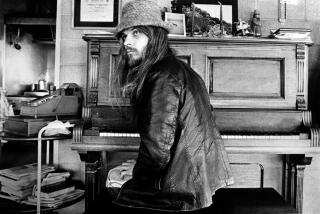The Legacy of Artist Charlie Russell : Montana Reveres Man Who Chronicled the Wild West
- Share via
GREAT FALLS, Mont. — There ain’t but one spot on Earth that I want to see, and that’s my Montana home . I want to stay here as long as I live . . . .
--Charlie Russell
No state is identified with an artist as much as Montana is with Charlie Russell.
Known as America’s “cowboy artist,” Russell lived from 1864 to 1926, capturing on canvas the colorful life of the Big Sky State’s early days. He chronicled the buffalo in the wild, the Indians, cowboys, early settlers, the open range and spirit of the West.
Charlie Russell Country, the official designation given the north-central sixth of Montana, includes the artist’s hometown of Great Falls and Helena, the capital.
Also bearing his name is the Charles M. Russell National Wildlife Refuge, 120 square miles of scenic wilderness that embraces the Missouri River and Ft. Peck Lake in northeastern Montana. High schools and elementary schools are named after him; so is a mountain.
There is even an annual statewide contest for schoolchildren who are asked to write an essay on “Why I Like Charlie Russell.” The winning composition is read in Great Falls at the widely acclaimed Charlie Russell Western Art Auction each March, Charlie Russell Month.
Each state honors two of its most famous citizens in Statuary Hall in the nation’s Capitol. Montana’s statues are tributes to Russell, the only artist so honored, and Jeannette Rankin, the first woman elected to Congress.
A square block of Great Falls (population 60,000) honors the memory of the cowpuncher-turned-artist, sculptor, poet, author and storyteller. Composing the complex are his home, which was built in 1900, his 1903 log-cabin studio next door, and the C. M. Russell Museum, one of the nation’s leading centers of Western art.
Russell’s wife, Nancy, who died in 1942, left the home and rustic studio to the city. Josephine Trigg, a Great Falls city librarian who lived next door, also willed her property and collection of 170 Russell originals to perpetuate his memory and work.
In 1953 the people of Great Falls raised $17,000 to establish a small gallery of Russell’s works with the Trigg collection as its nucleus. A $500,000 15,000-square-foot wing was added in 1966. And the museum gained an additional 26,000 square feet in November at a cost of $3 million.
Today the museum contains the best overall collection of Russell paintings, sculptures, illustrated letters, post cards and memorabilia.
Russell, who was born in St. Louis, left home at 15 to go to Montana. He lived in a trapper’s log shack the first year, cowpunching in the Judith Basin east of Great Falls. He was a night herdsman who lived and rode with Indians.
And he sketched.
He sketched almost everything in sight. In the beginning, he got $5 for his drawings or paintings and figured he was lucky.
“I am an illustrator,” he wrote. “There are lots better ones, but some worse. Any man that makes a living doing what he likes is lucky and I am that. Anytime I cash in now, I win.”
Russell died a wealthy man and counted many famous individuals in his circle of friends. President Theodore Roosevelt bought one of Russell’s bronze sculptures. Humorist Will Rogers was a buddy, as were actors William S. Hart and Douglas Fairbanks Sr. and oil magnate E. L. Doheny.
During Russell’s lifetime, his paintings, watercolors and bronze pieces were featured in exhibits in Los Angeles, Chicago, New York and London. He also wrote and illustrated books under his own name and that of Rawhide Rawlins, and did illustrations for books by other well-known Western writers and the Saturday Evening Post.
In 1911, the state commissioned him to paint a 12-by-25-foot mural that hangs above the Speaker’s platform in the state House of Representatives. The mural, “Lewis and Clark Meeting the Flathead Indians at Ross’ Hole,” is considered Russell’s masterpiece.
“We often speculate about the value of that mural, Charlie Russell’s largest painting,” said Ed Smith, 33, chief clerk of the House. “Charlie was paid $4,600. It took him six months. It’s got to be worth at least $5 million to $10 million.”
“When the Land Belonged to God,” showing wild buffaloes on a bluff overlooking the Missouri River, was painted for the 101-year-old Montana Club in Helena. Russell was paid $3,000 for the painting which was completed in 1914. The club sold the painting to the state in 1977 for $450,000. It hangs in the Russell Gallery of the Montana Historical Society across from the Capitol.
Fred Birch, a Great Falls contractor, paid $750,000 for Russell’s “Buffalo Hunt” and then presented it to the C. M. Russell Museum so it would remain in the artist’s hometown.
Today, 60 years after Russell’s death, his oils sell from $75,000 to $1 million, said Jerry Goroski, 37, assistant director of the C. M. Russell Museum: “His watercolors sell from $45,000 to $400,000; illustrated letters he wrote to friends, from $7,000 to $40,000; illustrated post cards, $5,000 to $10,000; bronze pieces, $3,500 to $40,000.”
An estimated 4,000 to 5,000 Russell originals are on exhibit and in private collections, though “there is no complete record of everything he did,” Goroski said. “We’re in the process of cataloguing every Charlie Russell painting, sculpture, illustrated letter and post card, whatever, known to exist.
“We’re never surprised when something new comes to our attention,” he said. “Charlie did his artwork on tablecloths, tent canvas, wood, metal, tin and glass. The buffalo skull was his emblem.”
Charlie Russell’s log-cabin studio is the way it was when the artist died of a heart attack on Oct. 24, 1926, at the age of 62. His easel holds an unfinished painting. A grizzly bearskin and an elk’s head hang from the walls. Also scattered about the room are props he used for his paintings: guns, saddles, boots, Indian feather capes, a cradle board and a travois. Guides in the studio, Russell’s home and the museum are often people who knew the artist when they were children.
Art Jacques, 70, a Great Falls ham radio operator for 55 years, was Russell’s neighbor. He was 10 when the artist died. “A bunch of us kids would walk down his alley to and from school,” he said. “We would stop and look at a saddle horse, Neenah, tied to a tree behind a studio. We’d peek in the studio and watch him paint. We never bothered him; he never bothered us.”
John Kegler, 69, of Palos Verdes Estates and retired principal of San Pedro Adult School, remembers Russell when he spent six summers at Lake McDonald in Glacier National Park. Kegler’s father ran a string of saddle horses at the lake.
“Charlie loved horses,” said Kegler. “He would stop by to visit with Dad. He painted in Bull Head Lodge, his summer cabin on the lake. I would watch him paint in his studio. He was a wonderful guy as far as this little boy was concerned.”
More to Read
The biggest entertainment stories
Get our big stories about Hollywood, film, television, music, arts, culture and more right in your inbox as soon as they publish.
You may occasionally receive promotional content from the Los Angeles Times.










